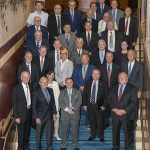On June 26, 2004, the United States of America and the European Community (EC) established the “Agreement on the Promotion, Provision and Use of Galileo and GPS Satellite-Based Navigation Systems and Related Applications” (A copy of this agreement can be found at the website of the U.S. Space-Based Positioning, Navigation, and Timing (PNT) Executive Committee through the URL address provided in reference [1] in the “Additional Resources” section near the end of this article.)
On June 26, 2004, the United States of America and the European Community (EC) established the “Agreement on the Promotion, Provision and Use of Galileo and GPS Satellite-Based Navigation Systems and Related Applications” (A copy of this agreement can be found at the website of the U.S. Space-Based Positioning, Navigation, and Timing (PNT) Executive Committee through the URL address provided in reference [1] in the “Additional Resources” section near the end of this article.)
One aspect of the agreement was to adopt a common baseline signal to be transmitted in the future by Galileo and GPS civil signals at the L1 center frequency of 1575.42 MHz. Although the agreement established BOC(1,1) as the baseline for the Galileo L1 Open Service (OS) and GPS future L1C signals, it also stated that the parties shall work together toward achieving optimization of that modulation for their respective systems, within the constraints of the Agreement.
A recent joint design activity involving experts from the United States and Europe has produced a recommended optimized spreading modulation for the L1C signal and the Galileo L1 OS signal. Details of this recommendation can be found in two documents available on-line at the NAVSTAR GPS Joint Program Office (JPO) website through the URLs provided as references [2] and [3] in the Additional Resources section. The United States is willing to adopt for GPS L1C either the baseline BOC(1,1) or the recommended MBOC modulation, consistent with what is selected for Galileo L1 OS.
The spreading modulation design places a small amount of additional power at higher frequencies in order to improve signal tracking performance.
Figure 1 shows the resulting signal structure plan for GPS and Galileo in the L1 band that would result from the recommended changes.
This article describes the spreading modulation’s power spectral density (PSD), as well as alternative spreading time series and their autocorrelation functions. In addition, it shows various measures that contrast the performance differences between the optimized modulation and other modulations. The article concludes by summarizing the status of the common spreading modulation and the way ahead.
(For the rest of this story, please download the complete article using the PDF link above)




